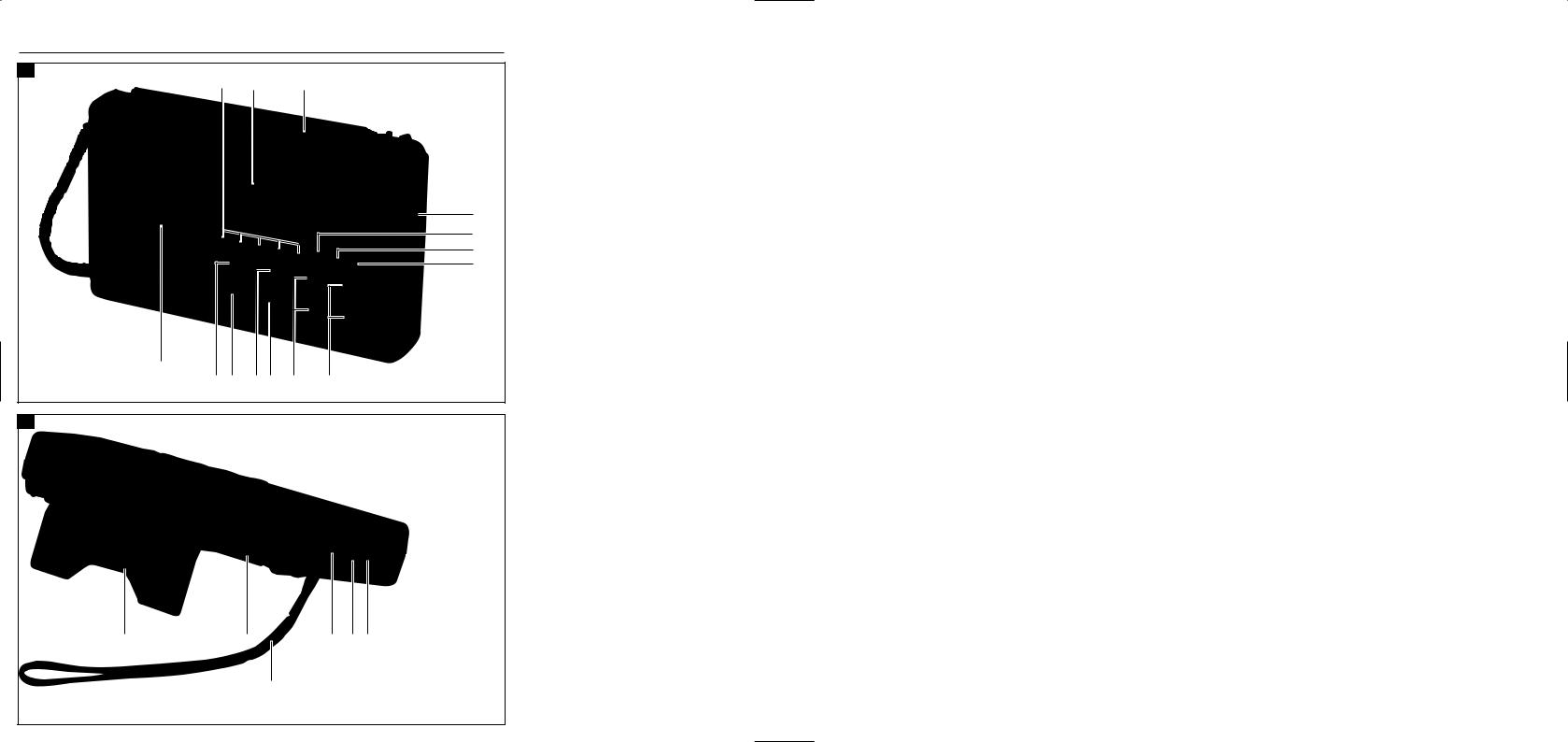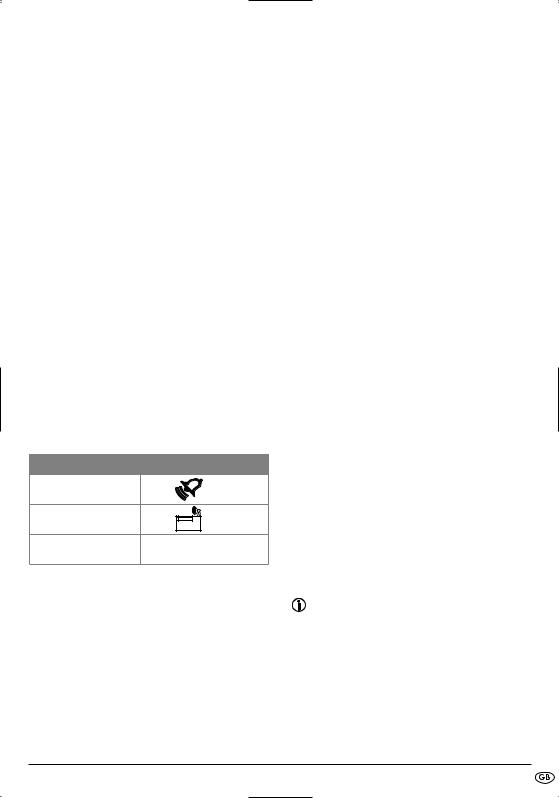Silvercrest KH 2029 User Manual

3C
MULTI-BAND RADIO
KH 2029
MULTI-BAND RADIO
Operating instructions
RADIO
Betjeningsvejledning
KOMPERNASS GMBH · BURGSTRASSE 21 · D-44867 BOCHUM
www.kompernass.com
ID-Nr.: KH2029-07/08-V1

KH 2029
A
q w e
r
t
y u
g
f d s a o i
B
h |
j |
l ; 2) |
k

CONTENT |
PAGE |
Intended use |
2 |
Technical Data |
2 |
Safety information |
3 |
Operating elements |
4 |
Starting up |
5 |
Unpack the device ........................................................................................................................... |
5 |
Check package contents ................................................................................................................. |
5 |
Mains and battery operation .......................................................................................................... |
5 |
General functions |
6 |
Key lock ............................................................................................................................................. |
6 |
Screen lighting .................................................................................................................................. |
6 |
Stand.................................................................................................................................................. |
6 |
Time functions |
6 |
Time, date, time zone and world time............................................................................................ |
6 |
Select display mode......................................................................................................................... |
8 |
Alarm function................................................................................................................................... |
9 |
Stop watch function ....................................................................................................................... |
10 |
Countdown function....................................................................................................................... |
10 |
Radio operation |
11 |
Setting the station ........................................................................................................................... |
11 |
Fine tuning....................................................................................................................................... |
12 |
Aerial............................................................................................................................................... |
12 |
Memory functions .......................................................................................................................... |
12 |
Cleaning |
13 |
Cleaning the housing..................................................................................................................... |
13 |
Disposal |
13 |
Warranty & service |
14 |
Importer |
14 |
Read the operating instructions carefully before using the appliance for the first time and preserve this booklet for later reference. Pass the manual on to whomsoever might acquire the appliance at a later date.
- 1 -

MULTI-BAND RADIO KH 2029
Intended use
This device is designed to receive generally approved radio transmissions in all countries (world receiver) and only for domestic use.
It has not been designed to receive transmissions that are not generally approved, nor as part of safety radio systems, e. g. on board sports boats, nor for industrial or commercial use. It has also not been designed for use in temperatures beyond those stated in the Technical Data.
Technical Data
This device has been tested and approved for adherence to the basic requirements and the other relevant regulations of the EMC Directive 2004/108/EC.
Power consumption: |
5 W |
Power consumption |
|
Standby: |
1.3 W |
Operating |
|
temperature: |
+ 5 ~ + 35° C |
Humidity: |
5 ~ 90 % |
|
(no condensation) |
Dimensions |
|
(L x W x H): |
180 x 40 x 110 mm |
Weight: |
Approx. 380 g |
Batteries
4 x 1.5 V, Type AA/LR6/Mignon (not supplied)
Frequency range radio
VHF (FM) |
87–109 MHz |
|
SW |
5.85–17.90 MHz |
|
MW (AM) Europe |
522 |
–1656 kHz |
MW (AM) USA |
520–1710 kHz |
|
LW |
144 |
–299 kHz |
The technical features of the device enable the frequency ranges stated above to be set. Various countries may have different national rules on the radio frequency ranges assigned. Please note that you may not sell, transfer to third parties or abuse information received outside the assigned radio frequency ranges.
Tuning ranges
FM (VHF) |
100 kHz/50 kHz |
SW |
5 kHz/1 kHz |
MW (AM) Europe |
9 kHz/1 kHz |
MW (AM) USA |
10 kHz/1 kHz |
LW |
1 kHz |
Sensitivity: |
SW can be set to 2 intervals |
General
Memory spaces: |
400 stations |
Headphone |
|
output: |
3.5 mm stereo socket |
Headphone output
Maximum |
|
output voltage: |
30-60 mV |
- 2 -

Safety information
•This device has not been designed for use by people (including children) with restricted
physical, sensory or intellectual abilities or lack of experience and/or knowledge, unless they are supervised by a responsible person (for their own safety) or have received instructions on how to use the device.
•Children should be supervised to ensure that they do not play with the device.
•In order to avoid the device being switched
on unintentionally, remove the adapter from the mains socket after each use and before cleaning.
•Check the device and all parts for visible damage. The device’s safety concept can only work if the device is in perfect condition.
•The mains adapter must always be freely accessible so that the device can be separated from the power supply quickly in an emergency.
•Do not expose the device to rain or use it in a damp or wet environment.
•Ensure that the connection cable is never wet or damp when in use.
•You must not open or repair the device’s housing. This can be dangerous and renders the warranty null and void.
•Protect the device from moisture and sprayed water. Therefore do not place any objects filled with water (e. g. vases) on or near the device.
Risk of fire!
•Do not use the device near hot surfaces.
•Do not set the device up where it is exposed to direct sunlight. This could cause it to overheat and damage it beyond repair.
•Never leave the device unattended during operation.
•Never cover the device’s ventilation slots when it is switched on.
•Do not place open flames, such as candles, on or near the device.
Risk of electric shock!
•Only connect the device to a properly installed and earthed mains socket. The mains voltage must agree with that stated on the mains adaptor specification plate.
•Damaged adapters or mains cables should be exchanged immediately by an authorised technician or the Customer Service in order to avoid risks.
•Connection cables or devices that do not work perfectly or have been damaged should be repaired or exchanged immediately by Customer Services.
Never immerse the device in water! Simply wipe it with a slightly damp cloth.
Risk of injury!
•Keep children away from the connection cable and device. Children frequently underestimate the danger of electrical devices.
•If the device has fallen down or is damaged it must no longer be used. Have the device checked by a qualified specialist and, if necessary, repaired.
•Batteries must not be handled by children. Children can put batteries in their mouths and swallow them.
If a battery has been swallowed, obtain medical assistance immediately.
- 3 -

 Thunder storms!
Thunder storms!
Devices connected to mains power can be damaged during a thunder storm. If there is a thunder storm, always remove the mains plug from the socket.
•If the appliance is not going to be used for long periods, remove the batteries.
•If batteries leak, put on protective gloves.
•Clean the battery compartment and contacts with a dry cloth.
 Information on voltage surges (EFT/electrical fast transient) and electrostatic discharges:
Information on voltage surges (EFT/electrical fast transient) and electrostatic discharges:
If the product does not work properly due to electrical fast transient processes (voltage surges) or electrostatic discharge, it must be reset to restore normal operation. If necessary, remove the plug from the power socket and insert it again. The batteries (if used) must be removed and reinserted.
 Information on separating the device from mains power
Information on separating the device from mains power
The POWER button on this device does not completely separate it from the mains network. In addition, the device uses power when in standby mode. In order to completely separate the device from the mains supply the plug must be removed from the mains socket.
 Notes on handling batteries
Notes on handling batteries
The device uses batteries. Please note the following on handling batteries:
 Risk of explosion!
Risk of explosion!
Do not throw batteries into a fire.
Do not recharge batteries.
•Never open, solder or weld batteries. There is a risk of explosion and injury!
•Check batteries regularly. Leaking batteries can damage the device.
 Caution!
Caution!
No liability/warranty applies to damage to the device caused by moisture due to water penetrating the device or overheating!
Operating elements
Front side
1 Memory buttons M.0/5–M.4/9
2Screen
3Button SNOOZE
4 Frequency selection switch
5 Button PAGE
6 Button FINE
7 Button POWER
8Buttons UP/DOWN
9 Buttons VOL.+ (AL–1)/VOL.– (AL–2)
0 Button MODE
qButton BASS
w Button MEMORY SCAN
e Button MEM
rSpeakers
Back
t Stand
zAerial
u Carrying strap
iSwitch SW SEN.
oHeadphone output
p DC INPUT 7.5 V: Adapter slot
- 4 -

Starting up
Unpack the device
Remove all packaging materials.
Caution!
Do not let children play with the plastic film. There is a risk of suffocation.
Check package contents
When unpacking, ensure that the following parts are included:
•world receiver
•these operating instructions with warranty card
Mains and battery operation
When you disconnect the radio from the mains supply, any settings you may have made (time, alarm, stations in memory) will be lost. If you wish to keep these settings, insert batteries (see below) before disconnecting.
Inserting batteries
Instead of using the mains adapter, you can run the radio from batteries (not supplied). You will need four 1.5 V mignon batteries, size AA, LR6.
•Open the battery compartment on the rear of the device by sliding the cover downwards.
•Insert four batteries into the compartment, paying attention to the polarity.
•Replace the cover on the battery compartment.
If the batteries are too weak, this is indicated on the screen by a flashing symbol 

 .
.
Mains connection
•Connect the plug of the mains adapter
to the DC INPUT 7.5 V socket on the side of the device.
•Plug the mains adapter into an easily accessible socket. To avoid tripping hazards, please avoid using an extension cable.
 Caution!
Caution!
Only use an adapter with an output voltage of 7.5 V / 400 mA and check the polarity of the device’s plug (  ). The use of adapters with a different output voltage may result in damage to the device or mains adapter.
). The use of adapters with a different output voltage may result in damage to the device or mains adapter.
Automatic time update
•As soon as the mains adapter is connected or batteries inserted, the world receiver starts in time mode. The screen repeatedly shows
PLEASE WAIT SYSTEM SETTING.
If an RDS signal is received, the time and date are set automatically. The correct time will then be shown on the screen.
If the time is not correct, set the date and time manually as shown below.
Connecting headphones
On the left side of the radio, you will find the headphone socket.
•Insert the headphone jack plug into the headphone output.
The speaker will be deactivated automatically.
Caution!
Listening to music with headphones over long periods of time and at a high volume may damage your hearing!
- 5 -

General functions
Key lock
In order to prevent changing the settings unintentionally by touching the buttons, you can activate the key lock.
•Press and hold down the MEM button for around 3 seconds. The screen will flash  . All buttons except the SNOOZE button are now locked.
. All buttons except the SNOOZE button are now locked.
•Press and hold down the MEM button again for about 3 seconds to cancel the key lock. The  message on the screen disappears.
message on the screen disappears.
Screen lighting
•Press any button to illuminate the screen.
The screen will remain lit for about 10 seconds.
Stand
•Flip out the stand on the rear of the device to enable it to stand more stably.
Time functions
The time functions can only be set when the radio is switched off. If the time cannot be set using the RDS signal, the default time of the world receiver starts at
0:00 00.
The settings are lost if the device is disconnected from its power supply.
Time, date, time zone and world time
You can use the MODE button to set the time, date and time zone, query the world time and set the date alarm, medium wave reception, alarm time reception, hourly mode and time update.
When you press MODE, the function to be set flashes for about 15 seconds. During this time, adjust the setting with the UP/DOWN buttons.
•Press MODE x 1: Set clock time.
•Press MODE x 2: Set the date.
•Press MODE x 3: Set time zone („Local city”).
•Press MODE x 4: Show world time.
•Press MODE x 5: Date alarm.
•Press MODE x 6: Set reception range for medium wave.
•Press MODE x 7: Set alarm pause.
•Press MODE x 8: Set 12/24 hour mode.
•Press MODE x 9: Set automatic time query.
To apply a setting, just wait until the screen stops flashing (the screen reverts to the time indication) or press MODE to move on to the next function.
Setting clock time
•Press MODE once. The most recently set time flashes on the screen.
•Press the UP or DOWN button to move the time forward or backward at minute intervals. Hold down one of the buttons for a few seconds to move the setting forward or backward quickly at 10 minute intervals.
Note:
Set the time without summer time offset. If summer time is required, this can be set when setting the time zone (see below).
- 6 -

Setting the date
•Press MODE again or twice.
The date set flashes on the screen (Tu 01:01 08 when first switched on).
•Press the UP or DOWN button to move the date forward or backward. Keep either of these buttons pressed for a few seconds to change the date in ten-day steps.
The weekday indication follows automatically. The indication uses the first two letters of the English name of the day.
The built-in calendar runs from 2000 to 2099.
Day of the week indication:
Su = Sunday
Mo = Monday
Tu = Tuesday
We = Wednesday
Th = Thursday
Fr = Friday
Sa = Saturday
Setting the time zone
•Press MODE again or three times. The selected time zone flashes on the screen as the abbreviation for the corresponding city (UTC when first switched on); the time disappears.
•Press the UP or DOWN button to move the time zone forward or backward.
The following table summarises the city abbreviations for the time zones and time differences.
Συντοµο- |
∆ιαφ. ώρας |
Πόλη |
γραφία |
Κ. Ευρ. |
|
|
|
|
HNL |
–10:00 |
Χονολουλού/ΗΟΑ |
|
|
|
ANC |
–9:00 |
Ανκοράζ/ΗΠΑ |
|
|
|
YVR |
–8:00 |
Βανκούβερ/Καναδάς |
|
|
|
LAX |
–8:00 |
Λος Άντζελες/ΗΠΑ |
|
|
|
DEN |
–7:00 |
Ντένβερ/ΗΠΑ |
|
|
|
CHI |
–6:00 |
Σικάγο/ΗΠΑ |
|
|
|
MEX |
–6:00 |
Πόλη του Μεξικό/Μεξικό |
|
|
|
NYC |
–5:00 |
Νέα Υόρκη/ΗΠΑ |
|
|
|
YYZ |
–5:00 |
Τορόντο/Καναδάς |
|
|
|
YUL |
–5:00 |
Μόντρεαλ/Καναδάς |
|
|
|
CCS |
–4:00 |
Καράκας/Βενεζουέλα |
|
|
|
RIO |
–3:00 |
Ρίο ντε Τζανέιρο/Βραζιλία |
|
|
|
BUE |
–3:00 |
Μπουένος Άιρες/Αργεντινή |
|
|
|
UTC* |
0:00 |
Παγκόσµια Συντονισµένη Ώρα |
|
|
|
LON |
0:00 |
Λονδίνο/Μεγάλη Βρετανία |
|
|
|
MUN |
1:00 |
Μόναχο/Γερµανία |
|
|
|
FRA |
1:00 |
Φρανκφούρτη/Γερµανία |
|
|
|
PAR |
1:00 |
Παρίσι/Γαλλία |
|
|
|
ROM |
1:00 |
Ρώµη/Ιταλία |
|
|
|
CAI |
2:00 |
Κάιρο/Αίγυπτος |
|
|
|
IST |
2:00 |
Κωνσταντινούπολη/Τουρκία |
|
|
|
MOW |
3:00 |
Μόσχα/Ρωσία |
|
|
|
KWI |
3:00 |
Πόλη του Κουβέιτ/Κουβέιτ |
|
|
|
DXB |
4:00 |
Ντουµπάι/Σαουδική Αραβία |
|
|
|
KHI |
5:00 |
Καράτσι/Πακιστάν |
|
|
|
DAC |
6:00 |
Ντάκα/Μπαγκλαντές |
|
|
|
BKK |
7:00 |
Μπανγκόγκ/Ταϊλάνδη |
|
|
|
SIN |
8:00 |
Σιγκαπούρη |
|
|
|
HKG |
8:00 |
Χονγκ Κονγκ |
|
|
|
PEK |
8:00 |
Πεκίνο/Κίνα |
|
|
|
TYO |
9:00 |
Τόκιο/Ιαπωνία |
|
|
|
SYD |
10:00 |
Σίδνεϊ/Αυστραλία |
|
|
|
NOU |
11:00 |
Νουµέα/Νέα Καληδονία |
|
|
|
AKL |
12:00 |
Ώκλαντ/Νέα Ζηλανδία |
|
|
|
*UTC
UTC (Universal Time Coordinated UTC) is the reference for the times of the various time zones around the world.
- 7 -

Summer time offset
•While the time zone indication is still flashing, press the SNOOZE button. The screen shows the SUN OFF message when summer time has been deactivated.
•Press the SNOOZE button again. The screen now shows SUN ON. Summer time offset is now activated and the clock moves one hour ahead.
Show world time
•Press MODE again or four times to show the world time. The city abbreviation appears with the corresponding time.
•Press the UP or DOWN button to move the time zone forward or backward.
Special date alarm
•Press the MODE button a fifth time to set the special date alarm. The screen flashes SDA1 and the date in succession.
•Press the PAGE button to select one of the ten settable date alarms (SDA1–SDA10).
•Press the UP or DOWN button to set the date on which the alarm should sound.
•Press the SNOOZE button to ignore the year number setting so that the alarm sounds every year.
•If the current date is the same as the SDA date, an alarm sounds every hour from 8 o’clock on this day. In addition, the SDA message will flash on the screen.
•Turn off the alarm by pressing any button.
Note:
In order to completely deactivate the date alarm set a date that is in the past!
Setting 12/24 hour mode
•Press MODE eight times. The screen shows the 24 HR message for 24 hour mode.
•Press the UP button to set the 24 hour mode.
•Press the DOWN button to set the 12 hour mode.
12 HR is displayed on the screen. In the afternoon in addition PM is shown on the screen.
Automatic update (RDS)
The RDS signal transfers additional information such as the station name, time or song title to the radio. The time is updated automatically when the RDS signal is received.
•Press MODE nine times. The screen displays UPDA ON if the update function is activated.
•Press the UP button to activate the automatic update.
If the radio is switched on, a clock symbol now flashes to the top left of the screen. The time is now updated automatically if a station with an RDS signal is received. The update is complete when the clock symbol stops flashing and is displayed permanently.
•Press the DOWN button to deactivate the automatic update. The screen displays UPDA OFF. When the radio is switched on, no clock symbol is displayed.
Select display mode
You can select which information is shown on the screen when the radio is switched off.
The selected mode is indicated by a corresponding symbol on the screen.
- 8 -

When the radio is switched off, select the display mode by repeatedly pressing the FINE button in accordance with the following table:
Symbol on the screen display mode:
CLK |
only the time is displayed. |
CITY |
the time and world time are shown |
|
in succession. |
DATE |
the time and date are shown in |
|
succession. |
CIT DAT |
the time, date and world time are |
|
shown in succession. |
Alarm function
The world receiver provides two alarms that can
be set independently of one another, AL1 and AL2. For both, you can set ...
... whether the alarm should operate on every day of the week or only from Monday to Friday;
... whether you wish to be woken by the alarm tone or the radio.
Setting the alarm time
You can set two alarm times in your world receiver.
Alarm function |
Symbol on the screen |
Acoustic signals |
|
Radio |
|
Switched off |
No symbol |
•Press the VOL.+/AL–1 (or VOL.–/AL–2) button. The screen shows the most recently set alarm time and the symbol for the alarm type.
•Press the UP or DOWN button to move the alarm time forward or backward at minute intervals. Hold down one of the buttons for a few seconds to move the setting forward or backward quickly at 10 minute intervals.
•Press the VOL.+/AL–1 (or VOL.–/AL–2) button until the desired alarm function (see table above) is indicated on the screen.
•Press the SNOOZE button to set the weekday on which you want the alarm to sound:
You can choose between week days
(Mo, Tu, We, Th, Fr), weekend (Su, Sa), every day (Su, Mo, Tu, We, Th, Fr, Sa) or the current day of the week. The selected setting is shown on the screen.
•Press the SNOOZE button until the desired alarm days are set. Hold down the SNOOZE button until the screen shows an individual week day.
•Press the SNOOZE button to set the desired week day.
To go back to selecting week days, weekend or every day, briefly hold down the SNOOZE button again.
•Press the MODE button to save the setting and return to the time mode. The setting is also saved if you wait around 15 seconds until the screen returns to displaying the time.
When the alarm sounds ...
•and the „Radio” alarm function has been selected, the radio operates for one hour at
a predefined alarm volume. To switch off press the VOL.+/AL–1 (or VOL.–/AL–2) button.
•and the „signal sounds” alarm function has been selected, the signal sound is played for 10 minutes. To switch off press the VOL.+/AL–1 or VOL.–/AL–2 button.
Note:
Please note that a station must be selected (see below) for the radio alarm to work.
- 9 -
